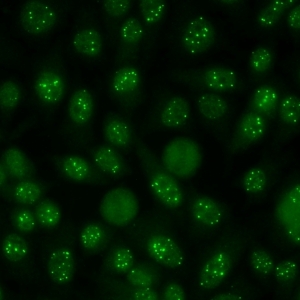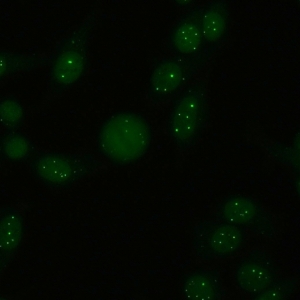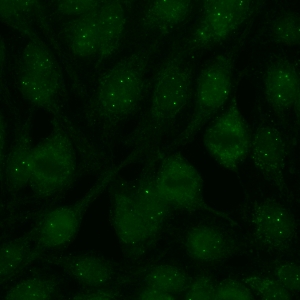     |
|
| Previous Nomenclature | 6-20 nuclear dots, NSpI, PML bodies |
| Description | Countable discrete nuclear speckles (6 to 20 nuclear dots/cell). e.g. SP-100 |
| Antigen Association | Sp-100, PML proteins, MJ/NXP-2 |
|
Clinical Relevance
First level information About Clinical Relevance & List of Abbreviations |
|
▶ Found in a broad spectrum of autoimmune diseases, including PBC, AIM (DM), as well as other inflammatory conditions (34) ▶ If PBC is clinically suspected, it is recommended to perform follow-up tests for anti-Sp100 (and PML/Sp140) antibodies; in particular anti-Sp100 antibodies have the best clinical association with PBC and have added value, especially when associated with AMA; the Sp100 (and PML-Sp140) antigen is included in disease specific immunoassays (i.e., liver profile*) (17, 35, 36) ▶ If DM is clinically suspected, it is recommended to perform a follow-up test for anti-MJ/NXP-2 antibodies; these anti-MJ/NXP-2 antibodies are highly specific for AIM, are found in up to one third of patients with juvenile DM, and have been reported to be associated with malignancies in adult AIM patients; the antigen is included in disease specific immunoassays (i.e., inflammatory myopathy profile*) (37–39) *Availability of the inflammatory myopathy profile, the SSc profile and the (extended) liver profile may be limited to specialty clinical laboratories. |
| First level information references |
|
17. Conrad K, Schössler W, Hiepe F. Autoantibodies in organ specific autoimmune diseases. a diagnostic reference. 8. 2th edn. Autoantigens autoantibodies autoimmunity, 2017. 34. Cozzani E, Drosera M, Riva S, et al. Analysis of a multiple nuclear dots pattern in a large cohort of dermatological patients. Clin Lab 2012;58:329-32. 35. Hu SL, Zhao FR, Hu Q, et al. Meta-analysis assessment of gp210 and Sp100 for the diagnosis of primary biliary cirrhosis. PLoS One 2014;9:e101916. 36. Granito A, Yang WH, Muratori L, et al. PML nuclear body component SP140 is a novel autoantigen in primary biliary cirrhosis. Am J Gastroenterol 2010;105:125-31. 37. Ichimura Y, Matsushita T, Hamaguchi Y, et al. Anti-NXP2 autoantibodies in adult patients with idiopathic inflammatory myopathies: possible association with malignancy. Ann Rheum Dis 2012;71:710-3. 38. Benveniste O, Stenzel W, Allenbach Y. Advances in serological diagnostics of inflammatory myopathies. Curr Opin Neurol 2016;29:662-73. 39. Ceribelli A, Fredi M, Taraborelli M, et al. Anti-MJ/NXP-2 autoantibody specificity in a cohort of adult Italian patients with polymyositis/dermatomyositis. Arthritis Res Ther 2012;14. |
| Second level information |
|
None |
| Second level information references |
|
None
|
| FAQ |
|
How to deal with just a “nuclear speckled” IFA report? In my practice I have followed patients with ANA findings, with a nuclear speckled pattern (without specifying whether fine/dense/coarse), in patients with very heterogeneous phenotypes, some with a clinical picture that suggests further investigation of systemic autoimmune disease (one patient with proximal muscle weakness and skin thickening) and others who represent only non-specific findings. In such situations, as a precaution, I request more specific autoantibodies. However, this pattern (nuclear speckled pattern) is not described by the "ICAP" and I am in doubt about which antigenic association it represents, even to guide which autoantibody may be present and which ones to look after. How to interpret this pattern? Does the lab describe it when it is not possible to "refine" such a conclusion? Could this be associated with deficiency in the methodology, sample, interpretation? |